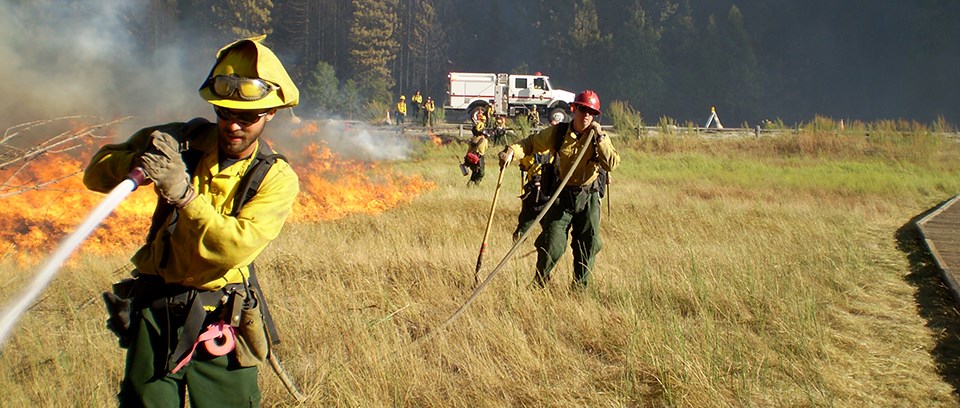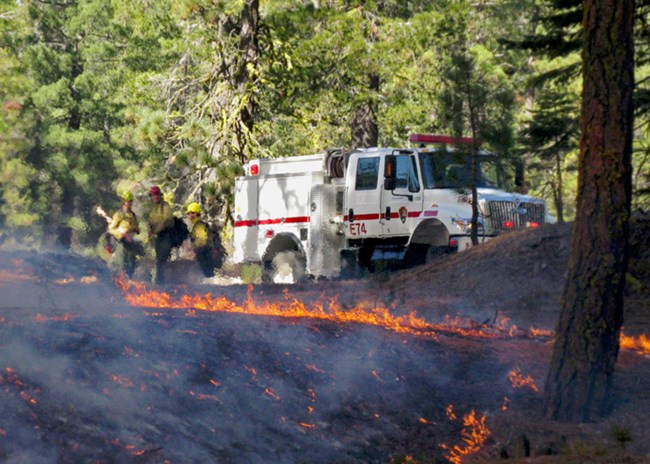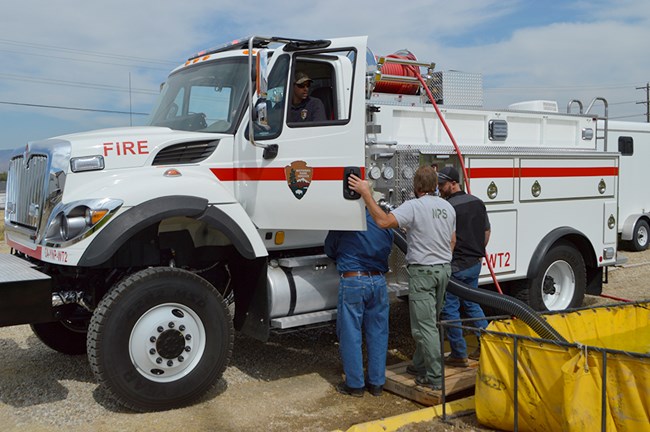Part of a series of articles titled Wildland Fire - Learning In Depth.
Article
Wildland Fire Engines

NPS
This article is part of the Wildland Fire Learning In Depth series. It is designed for students who want to learn more about fire. Find the complete series on the Fire subject site.
Fire Engines
Most parks are located away from urban areas and maintain their own wildland fire protection and suppression equipment, including wildland fire engines. They come in different sizes (types) depending upon how many gallons of water they hold and the gallons per minute (GPM) the pump can produce. Most wildland fire engines are four-wheel drive and have off-road capability. Some can “pump and roll”—drive slowly while deploying water. Engines such as Type 3's can pump from a stationary position using a power take off (PTO). All engines have Class A foam capability. While some parks have complete engine crews who provide fire protection, in many parks, fire protection is augmented by collateral duty park employees--employees who typically perform a different job, but are certified for firefighting as needed.
Water Tenders
Water tenders are used to move large amounts of water to remote locations in support of wildland fire operations. Although they are large, water tenders are generally operated by one or two firefighters. Water tenders are typically two-wheel drive and not for off-road use.
Engine Crews
Engine crews are used for initial attack on developing fires close to roads. The crew can hike or be flown to fires in more remote areas. During extended attack, engine crews support fireline production, structure protection, and helicopter operations. One advantage of engine crews is the ability to build "wet line,” which is fireline that uses water or foam in place of digging to mineral soil. This minimizes the impact to vegetation and limits erosion.
Water Handling Equipment
Many parks maintain a cache of pumps and water-handling equipment such as wildland fire hose and fittings. Pumps are of several different varieties and capacities, from small pumps for mopping up, to large pumps to support structure protection.

NPS/C. FARRIS
Wildland Engines
Type 3
-
A wildland engine with a minimum pump capacity of 150 GPM
-
At least 500-gallon tank
-
500 feet of 1 1/2" hose
-
500 feet of 1" hose
-
Gross vehicle weight rating (GVWR) generally greater than 26,000 pounds
-
Requires a minimum crew of 3
Type 4
-
A wildland engine with a minimum pump capacity of 50 GPM
-
At least 750-gallon tank
-
300 feet of 1 1/2" hose
-
300 feet of 1" hose
-
GVWR generally greater than 26,000 pounds
-
Requires a minimum crew of 2
Type 6
-
An initial attack wildland engine with a minimum pump capacity of 30 GPM
-
150-400 gallon tank
-
300 feet of 1 1/2" hose
-
300 feet of 1" hose
-
GVWR generally less than 26,000 pounds
-
Requires a minimum crew of 2
Type 7
-
A standard duty vehicle chassis
-
The vehicle has a small pump (10 GPM)
-
50-200 gallon tank
-
200 feet of 1" hose
-
Multipurpose unit used for patrol, mop up, or initial attack with a crew of 2

NPS/K. KIRBY
Water Tenders
Type 2
-
A water tender with a minimum pump capacity of 200 GPM
-
At least 2,500 -gallon tank
-
GVWR greater than 26,000 pounds
Type 3
-
A water tender with a minimum pump capacity of 200 GPM
-
1000-2500 gallon tank
-
GVWR greater than 26,000 pounds
- Duration:
- 4 minutes, 13 seconds
Wildland fire engines play a dynamic role in fire management operations throughout the national parks.
Last updated: October 11, 2019
